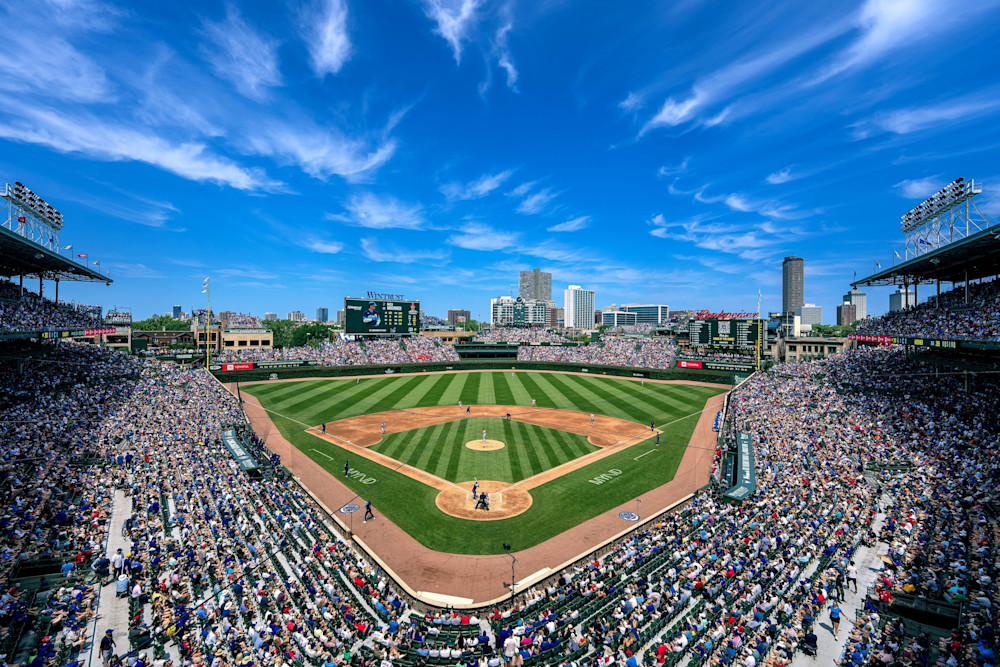Oct 9, 2025
·Mary Callahan

Few ballparks in America carry the history, charm and magic of Wrigley Field, the legendary home of the Chicago Cubs. Opened in 1914, Wrigley isn’t just a stadium—it’s a living piece of baseball history. From the hand-operated scoreboard to the ivy-covered outfield walls, every inch of the park tells a story. Today, Wrigley Field is as much about tradition as it is about modern entertainment, hosting not only Cubs games but also concerts, hockey games and community events.
If you’re planning a trip to Chicago, catching an event at Wrigley is a must. Here’s everything you need to know before you go.
About Wrigley Field
Location: 1060 W. Addison Street, Chicago, IL 60613
Opened: 1914 (originally as Weeghman Park; renamed Wrigley Field in 1927)
Capacity: ~41,649 for baseball
Primary Tenant: Chicago Cubs (MLB)
Other Events: College football, NHL Winter Classic, concerts, corporate events
Nestled in the heart of Chicago’s Wrigleyville neighborhood, the stadium is surrounded by lively bars, restaurants, and rooftops that extend the ballpark experience well beyond the gates.
A Look Back at Wrigley Field’s History
Originally built for the short-lived Chicago Whales of the Federal League, Wrigley Field became the Cubs’ home in 1916. Its iconic features, such as the ivy walls (planted in 1937), the red marquee sign, and the manual scoreboard, make it one of the most recognizable venues in sports.
Key moments in Wrigley Field history include:
First Cubs Game at Wrigley (1916): The Cubs beat the Cincinnati Reds 7–6.
World Series Glory (2016): Wrigley hosted the Cubs’ first World Series win in over a century, cementing its place in sports history.
Concert History: Stars like Pearl Jam, Lady Gaga, Paul McCartney and Billy Joel have performed here.
Other Sports: The Chicago Bears once played NFL games at Wrigley (1921–1970), and the stadium even hosted the NHL Winter Classic in 2009.
Getting to Wrigley Field
By Public Transit: Public transportation is by far the easiest way to get to Wrigley. The CTA Red Line’s Addison Station is right next to the ballpark, and bus routes also service the area.
By Car: Driving is challenging due to limited parking and heavy game-day traffic. Nearby garages and lots are available, but expect higher rates.
Rideshare: Uber and Lyft are popular choices, with designated drop-off/pick-up zones around the park.
Biking/Walking: The neighborhood is pedestrian- and bike-friendly, with bike racks near the stadium.
Seating at Wrigley Field
Wrigley Field offers a unique mix of classic charm and modern upgrades. Here’s a breakdown of the seating options:
Bleachers: Located in left and right field, these are general admission seats and the heart of Wrigley’s party atmosphere.
Lower Level (Infield & Dugout Seats): Some of the best views in the park, closest to the action.
Upper Deck: More affordable and scenic, offering sweeping views of both the field and Chicago’s skyline.
Club Level & Suites: Premium seating with food and drink service, indoor lounges and great sightlines.
Rooftop Seats: Across the street, privately owned rooftops offer food, drinks and incredible views of the game.
No matter where you sit, Wrigley’s intimate design ensures you feel connected to the game.
Food & Drink at Wrigley Field
The stadium offers a blend of traditional ballpark eats and Chicago specialties:
Classics: Hot dogs, nachos, popcorn, pretzels.
Chicago Favorites: Chicago-style hot dogs (no ketchup!), Italian beef sandwiches, deep-dish pizza slices.
Specialty Items: Elotes (Mexican street corn), smoked brisket sandwiches, vegan hot dogs.
Beer & Drinks: Domestic beers, craft brews from Goose Island, cocktails and non-alcoholic options.
Food stands are located throughout the concourse, with some sections offering unique items you won’t find elsewhere.
Atmosphere at Wrigley Field
A trip to Wrigley isn’t just about baseball—it’s about the experience.
Game Days: The crowd is passionate yet family-friendly, with fans singing “Go Cubs Go” after every victory.
Seventh-Inning Stretch: Guest conductors lead the singing of “Take Me Out to the Ballgame,” a tradition started by broadcaster Harry Caray.
Bleacher Vibes: Energetic and loud, especially during rivalry games with the Cardinals, Brewers, or White Sox.
Concerts: The historic ballpark transforms into an open-air music venue, attracting major artists every summer.
Stadium Policies
Bag Policy: Backpacks are prohibited. Small bags, purses and diaper bags are allowed but will be screened.
Mobile Tickets: All tickets are digital—download ahead of time for easy entry.
Cashless Payments: Concessions and retail are cash-free.
Prohibited Items: Outside food (except small snacks), large cameras, umbrellas and noisemakers.
Re-Entry: Not permitted once you leave the stadium.
Notable Events at Wrigley Field
2016 World Series Games: Cubs ended their 108-year championship drought.
NHL Winter Classic (2009): Chicago Blackhawks vs. Detroit Red Wings.
Historic Concerts: Paul McCartney, Lady Gaga, Pearl Jam, Foo Fighters and more.
College Football: Occasional Big Ten games, including Northwestern matchups.
Nearby Attractions in Wrigleyville
The area around Wrigley Field is as much of an attraction as the stadium itself.
Wrigleyville Bars: Murphy’s Bleachers, Cubby Bear and Old Crow Smokehouse are fan favorites.
Gallagher Way: A family-friendly plaza next to the ballpark with big screens, food vendors and community events.
Chicago Landmarks: Lake Michigan, Lincoln Park Zoo and downtown Chicago are all a short train ride away.
Food Stops: Giordano’s, Lou Malnati’s and Portillo’s for classic Chicago deep-dish and hot dogs.
Why Wrigley Field Stands Out
Wrigley Field is more than a ballpark—it’s a pilgrimage site for baseball lovers. With over a century of history, iconic features and passionate fans, it’s an experience unlike any other in Major League Baseball. Whether you’re in the bleachers with a hot dog and a beer, or singing during the seventh-inning stretch, Wrigley captures the essence of why we love the game.
Plan Your Visit with SeatGeek
From Cubs games and rivalry matchups to unforgettable concerts, Wrigley Field remains one of America’s premier live-event destinations. Use SeatGeek to compare tickets, explore seating charts and secure your spot at this Chicago landmark.